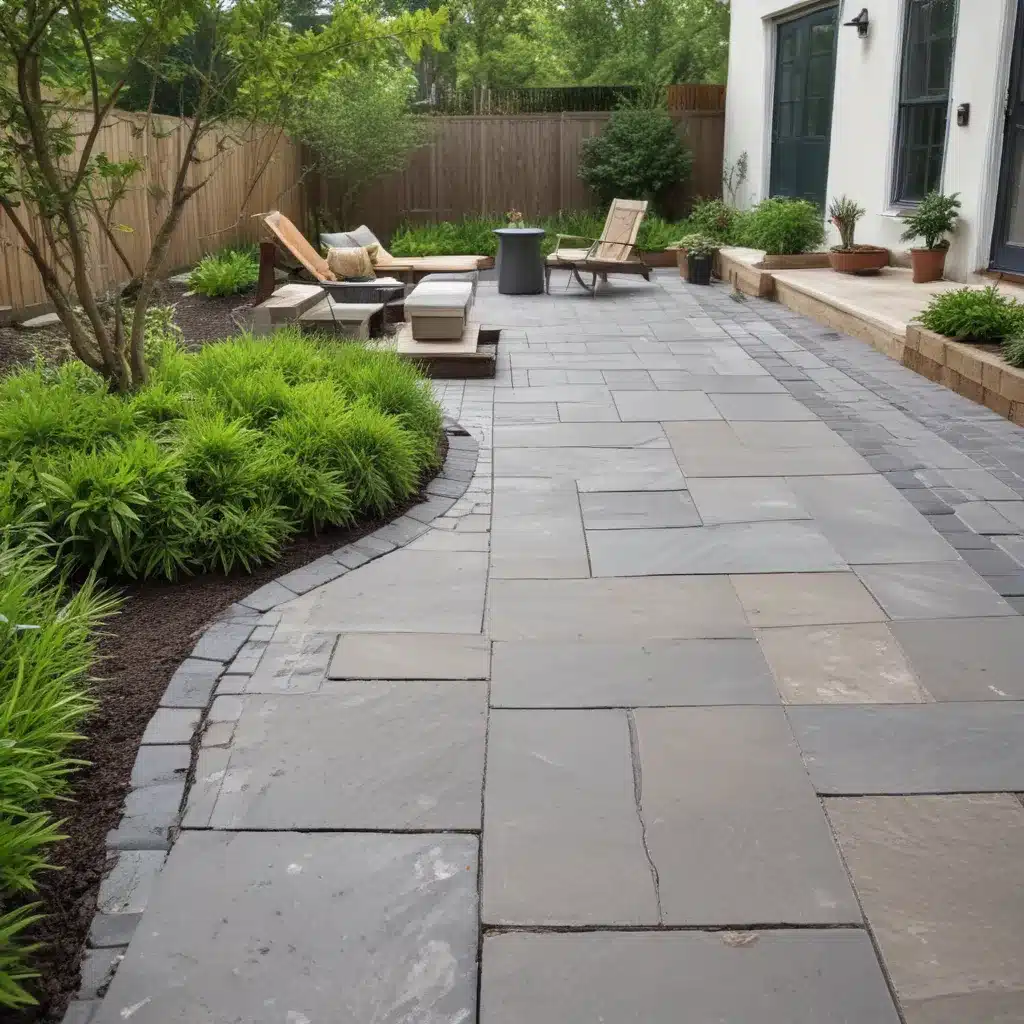
As an experienced outdoor living consultant, I’m excited to share insights on the latest eco-friendly patio paving, landscape design, and installation techniques that are revolutionizing the industry. In an era where environmental consciousness is paramount, homeowners and contractors alike are seeking innovative solutions to create sustainable, long-lasting outdoor living spaces.
Sustainable Paving Materials
Traditional concrete has long been a staple in patio construction, but its environmental impact is prompting a shift towards more eco-friendly alternatives. “Green concrete” – a type of concrete with at least one component derived from waste materials – offers a much more sustainable solution. By utilizing recycled materials like fly ash, a byproduct of coal combustion, green concrete can reduce carbon emissions by up to 25% compared to traditional mixes.
Another innovative option is hempcrete, a concrete-like material made from the woody core of the hemp plant. Hempcrete is incredibly eco-friendly, as hemp is a fast-growing, renewable resource that requires minimal water and no chemicals to cultivate. This versatile material not only sequesters carbon throughout its lifecycle but also provides natural insulation and moisture regulation properties.
Looking beyond concrete, mass timber has emerged as a stylish and sustainable choice for patio surfaces and structures. Engineered from composite wood systems, mass timber is often stronger than concrete or steel, yet much lighter and easier to transport. Its ability to sequester an estimated 1 metric ton of carbon dioxide per cubic meter makes it an excellent choice for eco-conscious outdoor living projects.
Permeable Pavement Solutions
Traditional impermeable patio surfaces can contribute to stormwater runoff and urban heat island effects. Permeable pavement alternatives, however, allow water to infiltrate through the surface, reducing runoff and recharging groundwater supplies. Options like porous concrete, permeable pavers, and even gravel or decomposed granite can transform a patio into a more environmentally-friendly, water-conscious feature.
These permeable solutions not only benefit the local ecosystem but also require less maintenance than traditional hardscaping. By mitigating pooling and puddling, permeable patios help extend the lifespan of the installation and reduce the need for energy-intensive snow/ice removal.
Integrated Landscape Designs
When designing an eco-friendly patio, it’s important to consider the surrounding landscape and how the two elements can work together harmoniously. Incorporating native plants and drought-tolerant species into the landscape helps reduce water consumption and enhances local biodiversity. Strategically placed trees and shrubs can also provide natural shade, reducing the need for energy-intensive cooling solutions.
Additionally, integrating green infrastructure like rain gardens, bioswales, and permeable pavement into the landscape design can help manage stormwater runoff, filter pollutants, and recharge groundwater supplies. These nature-based solutions not only benefit the environment but can also add visual interest and strengthen the connection between the patio and its surrounding ecosystem.
Nature-Inspired Aesthetics
Eco-friendly patio design doesn’t have to sacrifice style. Biophilic design principles, which seek to integrate natural elements and patterns into the built environment, can inspire stunning, nature-inspired aesthetics. Incorporating natural stone, wood, and earthy tones can create a warm, inviting ambiance, while strategically placed greenery and water features can evoke a sense of tranquility.
Beyond the patio surface, carefully selected eco-friendly lighting and furnishings can enhance the overall design. Solar-powered lighting, for instance, can illuminate the space without relying on the grid. And furniture made from recycled or sustainably-sourced materials can seamlessly blend functionality with environmental consciousness.
Efficient Construction Practices
Minimizing the environmental impact of patio installation is crucial for creating a truly eco-friendly outdoor living space. Contractors who specialize in sustainable construction can employ techniques that reduce waste, conserve resources, and protect the surrounding ecosystem.
This might include prefabricating elements off-site to minimize on-site disruption, or using recycled and repurposed materials whenever possible. Strategies like these not only streamline the installation process but also divert materials from landfills, contributing to a more circular economy.
Patio Maintenance Guidelines
Maintaining the long-term sustainability of an eco-friendly patio requires a thoughtful approach to cleaning and upkeep. Avoiding harsh chemicals and opting for natural, biodegradable cleaning products can prevent the introduction of pollutants into the local environment. Regular inspections and prompt repairs can also help extend the lifespan of permeable pavement and other eco-friendly patio materials.
Incorporating eco-friendly landscaping practices, such as mulching, integrated pest management, and water-efficient irrigation, can further enhance the sustainability of the overall outdoor living space. By taking a holistic approach to patio maintenance, homeowners can ensure their investment continues to benefit the environment for years to come.
Cost Comparisons and Considerations
While eco-friendly patio solutions may carry a higher upfront cost, the long-term savings and environmental benefits can make them a wise investment. Permeable pavement, for instance, can reduce the need for costly stormwater management infrastructure, while mass timber and hempcrete offer increased durability and reduced maintenance over time.
Moreover, many state and local governments offer incentives and rebates for homeowners who incorporate sustainable features into their outdoor living spaces. These programs can help offset the initial cost difference and make eco-friendly patio solutions more accessible to a broader range of homeowners.
As the demand for sustainable living continues to grow, the innovation and adoption of eco-friendly patio materials, designs, and installation techniques will only accelerate. By embracing these cutting-edge solutions, homeowners and contractors can pave the way to a greener future, one patio at a time. For more information on how Cincinnati Patiopaving can help you create an eco-friendly outdoor oasis, please don’t hesitate to reach out.

